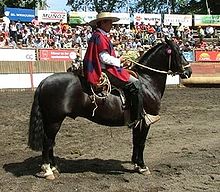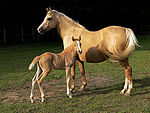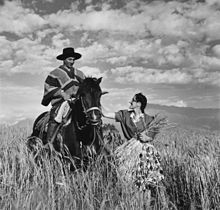- Chilean Horse
-
Chilean Horse 
Distinguishing features Hardy, low metabolism, high threshold for pain, great immunity to disease and a remarkable rate of recuperation. Alternative names Caballo chileno Country of origin  Chile
ChileHorse (Equus ferus caballus) The Chilean Horse is a breed virtually unknown[citation needed] outside South America despite being the oldest registered native American breed, the oldest registered breed of Iberian origin, the oldest registered horse breed in South America and the oldest registered stock horse breed in the Western Hemisphere.
Contents
History
Colony
The Chilean Horse's genealogy originates in New Castile (Peru). Most of the horses came from the fertile valleys of Charcas (now Sucre, Bolivia), but some of the finest stallions were selected from throughout the kingdom. The breed probably started around 1544 when the first Chilean horse breeder, Father Rodrigo González Marmolejo, started breeding equines in what was then known as New Toledo when the emphasis was on quality. By the turn of the 16th century, the Mapuches were outstanding horseman with growing numbers of horses which were trained as efficient war mounts. By the 17th century, Chile had very defined types in parade horses, pacers and trotters and the country had gained the reputation of having the best horses in South America.
Chilean Horses were selected for lateral dexterity, courage to confront and pin belligerent cattle and an even temperament that permitted a high degree of trainability while conserving needed energy for a long day's work. By the 18th century, the yearly round-ups that had been required by decree since 1557 took on massive dimensions. The pens that received cattle herded down from the mountainous terrain needed to have a capacity of no less than 7,000 head. Sorting the cattle by ownership, designated use, and requirements for castration and branding resulted in herding and pushing cattle down long alleyways into classifying pens. This gave rise to the aptitudes now used in the modern-day Chilean rodeo that are performed in a crescent-shaped arena known as a medialuna (half-moon arena).
The increasing area in wheat during this era gave rise to select groups of mares that formed threshing teams of between 50-100 animals. These mares performed a demanding task that required sure-footedness and boundless energy. Any animal that stumbled or slipped to its knees was sent to slaughter. Within a circular confine, with wheat up to their knees, these mares were expected to move on their own accord. These were the dams of some of the best 'corraleros' (rodeo horses) of the time. By the late 18th century, there were farms such as Principal, Catemu, Quilimuta, and Alhue that kept orderly records of the genealogy of the specialized horses they were breeding.
Republic
Throughout the 19th century, Chile’s independence from Spain brought on a clear preference for the stock and/or warhorse. This 'blue collared' equine variety that had always dominated the country's inventory, now also became the most prestigious breed elected to represent the newly-formed Republic of Chile. In this period. Chile had its most influential breeders. They more closely defined the characteristics of the Chilean Horse, as well as introducing a greater selection for speed, as match races at sprinting distances became popular throughout the country. The end of the 19th century brought with it a decline in agrarian property sizes, the use of thrashing machines that extinguished the need for thrasher mares, railroads and automobiles that greatly limited the use of the horse as a means of transport and the growth of specialized breeds that substituted the Chilean Horse in draft, carriage and racing needs. The saving grace of the Chilean Horse breed was the upsurge in the popularity of the Chilean rodeo.
The Chilean horse prior to 1850 was a closed breed type, due the absence of European breeds in a country that was convinced they had the best horses in South America. The isolation that resulted from the geographical definition of its borders also made imports less probable. When modern transport made new breeds more accessible, Chile was one of the last places in South America to see them arrive. Even so, the innumerable mountains, ridges and valleys over a 4,300 km (2,700 mi) long landscape assured that the purity of many Chilean Horses remained intact.
Faithful traditional breeders also were critical contributors to breed purity by not succumbing to the temptations of cross-breeding. The critical period that popularized the use of other breeds was shortened even more when Chile became the first country to register their national breed. The real stroke of genius was formalizing and popularising a sport where no other breed could be its equal.
Ever since the beginning of the 20th century, the sport of rodeo has become bigger and more organized. Meanwhile the qualities required to excel in this sport were increasingly implanted in the breeding of the Chilean Horse. Nothing has assured the purity of this breed more than its specialization in a sport for which it has been exclusively selected for over 150 years. Outcrossing to other breeds has never been a temptation since the Chilean Horse is well-suited for the Chilean rodeo sport.
To this day, speed rather than endurance is the criteria by which huasos (Chilean cowboys) value their horses. Although the registry was established in an effort to protect a 'national treasure' that was being endangered by the cross-breeding promoted by American enchantment with anything European, the Chilean Horse already had more than a century of selection along specific family lines.
Breed characteristics
Like many other native breeds in Latin America, the Chilean Horse is extremely hardy. It has a low metabolism, a high threshold for pain, a great immunity to disease and a remarkable rate of recuperation. Their hooves are strong and their thick double-hair coat makes them well-suited for both cold and dry/hot weather.
The breed has a very docile temperament and makes a very alert horse with a large capacity for work.
The Chilean Horse is not just the oldest stock horse breed in America, but is also is the only stock horse breed that has maintained a closed registry since its inception.
See also
References
- Araya Gomez, Alberto, (1989). El Caballo Chileno en el Siglo XX, Imprenta Gonzalo Amenábar H., Providencia, Santiago, Chile.
- Encina, Francisco A., (Nov.1934). “De Un Estudio Sobre el Caballo Chileno” El Campesino Magazine, Santiago, Chile.
- Prado P., Uladaricio, (1914). El Caballo Chileno 1541 a 1914, Estudio Zootécnico e Histórico Hípico, Imprenta Santiago, Santiago, Chile.
External links
Equine Equine science and
management
Equestrianism
and sportGlossary of equestrian terms · List of Equestrian Sports · Horse tack · Bit · Bridle · Saddle · Harness · English riding · Western riding · Driving · Horse training · Horse racing · Equestrian at the Summer Olympics (medalists, venues) · Horse show · EquitationEvolution and history Domestication · In warfare · In the Middle Ages · Horses in East Asian warfare · History of the horse in South Asia · Horses in the Napoleonic Wars · Horses in World War I · Horses in World War II · History of the horse in BritainHorse breeds, types
and other EquidaeList of horse breeds · Wild horse · Feral horse · Stock horse · Gaited horse · Draft horse · Warmblood · Sport horse · List of horse breeds in DAD-ISOther EquusHybridsCategory: Equidae Categories:- Horse breeds
- Horse breeds originating in Chile
- Chilean rodeo
Wikimedia Foundation. 2010.

